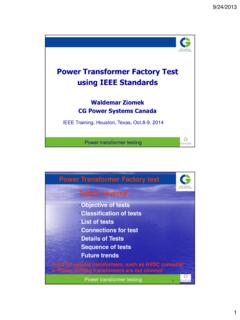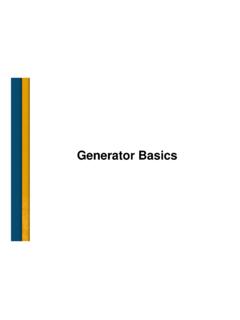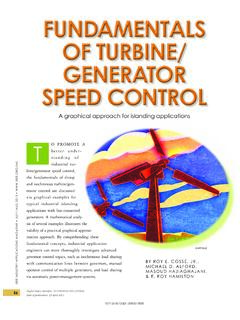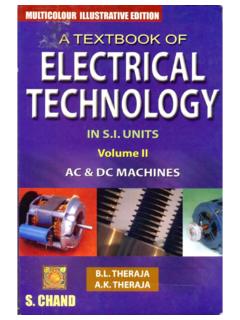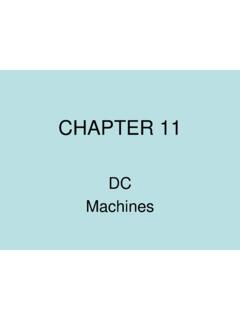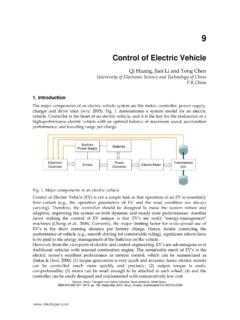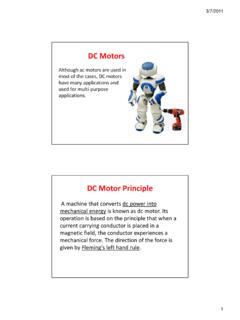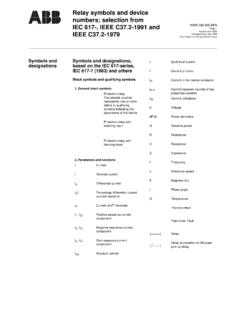Transcription of 7. Generator Testing IEEE
1 Generator TestingStandard Tests winding resistance Insulation resistance Hi-pot all windings Open circuit saturation curve Voltage and current balance of windings Voltage transient at rated kVA Voltage regulation and regulator adjust range Phase sequence Mechanical balance Options (RTDs, space )Standard Test Sheet1. winding resistance2. Insulation resistance3. High-potential test4. saturation data5. Phase balance6. Voltage transient (shown on next page)7. Voltage regulation8. Phase sequence9. Mechanical balance10.
2 Options (RTDs, space heaters)Voltage Transient Test SheetsVoltage dip on load applicationVoltage Transient Test Sheets (cont.)Voltage rise on load removalSpecial Tests Open-circuit saturation with slip rings Synchronous impedance curve (short-circuit saturation) Zero power factor saturation curve Summation of losses (efficiency test) Direct axis synchronous reactance (XD) Negative-sequence reactance (X2) Zero-sequence reactance (XO) Direct-axis transient reactance (X D) Direct-axis sub-transient reactance (X D)Special Tests (cont.)
3 Direct-axis transient short-circuit time constant (T D) Direct-axis sub-transient short-circuit time constant (T D) Short-circuit time constant of armature windings (TA) Direct-axis transient open-circuit time constant (T DO)Special Tests (cont.) Overspeed Hot or cold (or both) Coastdown after overspeed (another option) Voltage waveform (harmonic analysis) THD Deviation Factor TIF Bearing temperature rise test - Run until bearing temperatures stabilize, peak bearing temps reported winding temperature-rise test Run until windings have stabilized thermally, rise by resistance calculated Several options.
4 Standard, API, extended run time Vibration monitored and recorded during testCopyright Emerson 2014 Application Specific Special Tests To ensure accurate design, pricing, etc.. Must be communicated at RFQ Some tests first unit only May require agency witness Marine (ABS, DNV-GL, BV) Over speed Overload Transient at 60% Hi-pot and insulation resistance Air gap of exciter and PMG Sustained short circuit Possibly heat run and / or enclosure IP verificationApplication Specific Special Tests (cont.) Hazardous locations Class-1 Div-2 or Zone 2 Heat Run to determine winding temperature rise Test of space heaters (to verify maximum surface temperature) 110% overload for 1 hour OverspeedGenerator Efficiency Test Measurement methods: direct vs.
5 Indirect (summation of losses) method depends on the manufacturing plant test equipment Calculation methods: NEMA vs. IEC (usually higher ) I2R reference temp: (observed winding temperature rise + 25 C) or temps based on insulation class (95 C = Class B, 115 C for Class F) At site conditions, site ambient temp + winding temp rise (40 C + 80 C = 120 C) Method of guarantee Value may have a 10% tolerance on the stated lossVoltage Transients Can be stated as an amount of voltage dip or rise that occurs for a given load. ,15% dip for 60% load applied.
6 Can be specified as an amount of load (skVA) applied or removed with a given dip or rise, respectively. , 2,000 skVA, <20% V dip. Can be specified with definition of the exact loads being applied (load characteristics, sequence, and max allowable V dip required). What is the starting method? Across-the-line, How many machines are in parallel? Is there any preload on the Generator ? If so, what type? Voltage transient performance data given assumes constant speed. Remember to allow adequate room for momentary variation in driver Typical tolerance is +/- 15% of stated value for X d and X d per IEC60034-3 Unless stated otherwise, X d = 14% means < X d < Is there an absolute minimum or maximum value defined for a given project?
7 If so, we need to know! If an absolute minimum or maximum is defined, we can design accordingly to meet the requirement. Example: If there is a requirement for a minimum X d of 15%, we can design for a tolerance of +30% / -0% per IEC to be sure the result is above the minimum.

